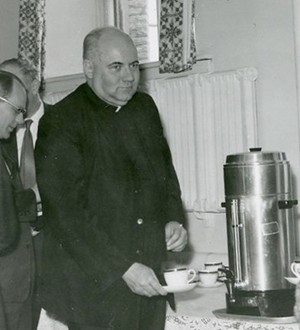Coffee brands in the 1960s

Image by Community Archives (public domain)
Tea was still Britain's favourite drink in the 60s and Britons consumed more tea per head than any other nationality. However, tea was going out of favour. More and more people were putting on the kettle to make a cup of instant coffee instead.
Coffee brought a touch of continental sophistication to the UK. In the latter years of the 50s, young people looked to France and Italy for inspiration. They frequented espresso bars as teenagers and developed a taste for coffee.
The generation gap spread to the choice of coffee or tea. Older people still preferred Britain's traditional cuppa, but by the end of the sixties, young housewives were stocking up with jars of instant coffee from Tesco, Sainsbury or Fine Fare instead.
Ground or instant?
Michael Caine, playing the fictional spy, Harry Palmer, demonstrated the perfect way to make a cup of ground coffee in the title sequence of the 'Ipcress File'. Take fresh beans, grind them, boil a kettle, add the ground coffee and water to a cafetiere and plunge.
Cafetieres were very chic. Most people either brewed their coffee in a saucepan or used a percolator. Lyons' was the most popular brand of ground coffee.
Instant coffee had been around since the 30s, but was not a big seller in the UK or the US, with most Americans preferring the taste of ground coffee. A famous study in the early 50s by Mason Haire of the University of California demonstrated the reason why. Two different groups of US housewives were shown two different shopping lists and asked to guess the personality of the shopper. One group used words, such as 'lazy' and 'poor planner' and in one case 'bad wife' to describe the woman who owned the first list. The other group had no such negative comments. How were the lists different? Only in one item. On the first list was a jar of Nescafé, on the second 1lb of ground coffee. Conclusion, US housewives thought instant coffee was for lazy people.
Opinions in the UK in the early 50s were similar. Advertisers countered this negative perception by stressing the flavour and aroma of instant coffee rather than convenience. By the end of the sixties one in 25 cups of coffee drunk was instant. In the late 50s the growth of supermarket trading provided anonymity. You didn't have to ask an assistant for instant coffee, so there was no-one to think you were lazy.
By the end of the sixties, instant coffee was re-habilitated. Housewives choosing instant were seen as busy, modern and outgoing. Whilst those preferring traditional coffee were viewed as dull and traditional.
Price may have also had something to do with the switch. A cup of coffee made from Lyons' ground coffee, the leading brand, cost threepence. One made from instant coffee cost less than a penny.
New blends and new processes
By the sixties there were many different blends and brands of instant coffee. For those with adventurous tastes Nescafé Blend 37 provided a quick way to enjoy strong continental style coffee.
By the end of the sixties a new process, freeze drying, was changing the instant coffee market. One of the first freeze dried instant coffees was Nescafé Gold Blend.
By the end of the decade these brands of instant coffee were available
- Express Aroma Rich - 4s 4d for 4oz
- Lyons - 3s 9d for 4oz
- Maxwell House 4s 11d for 4oz
- Nescafé 4s 11d for 4oz
- Nescafé Gold Blend 6s for 4oz
- Nescafé Blend 37 6s 4d for 4oz
- Summer Gold (United Dairies) - 4s 3d for 4oz
- Kenco Mild Roast 5s 6d for 4oz
- Kenco Continental High Roast - 3s 3d for 2oz
Source: Which report, 'Instant Coffee' November 1969'
Additionally own brand coffees were sold in supermarkets. Waitrose, Mac Fisheries, Pricerite, Safeway, Sainsbury's, Tesco, the Co-op, Fine Fare, Key Market, Marks and Spencer (St Michael), Woolworth's (Kingsmere), Littlewoods (Keynote), Mace, VG and Spar all had their own instant coffee brands.
The vast majority of instant coffees were pretty much the same, particularly the own brand versions Some had different flavours. Those closest to real coffee taste were the more expensive ones, for example Kenco Mild Roast, Nescafé Gold Blend and Nescafé Blend 37. Nothing much really changes in the world of instant coffee.
Decaf
By the sixties there were a small number of decaffeinated coffees available. It was a tiny market and few people saw a reason to drink decaf. However by 1969, you could get:
- Nestlé Decaf - 3s 11d for 2oz
- Café HAG 5s 3d for 4oz
- Symington's Decaffeinated
Read more
- Instant coffee brands from the 1970s - UK
- Coffee brands in the 1960s - USA
- History of the cafetiére
- How we used to make coffee


Comments